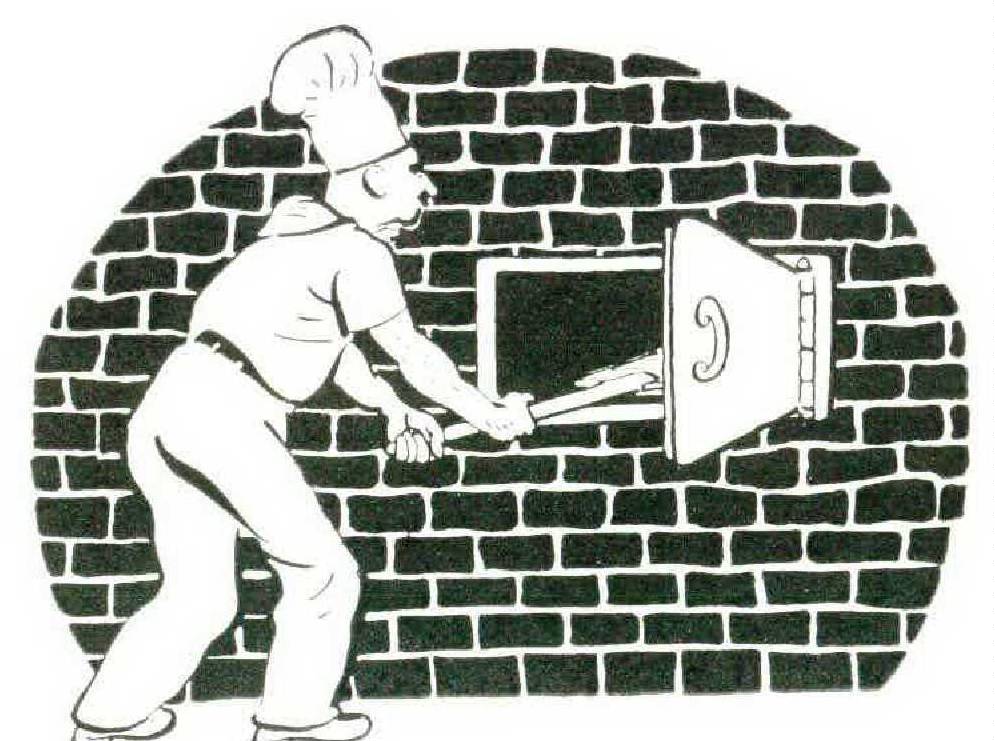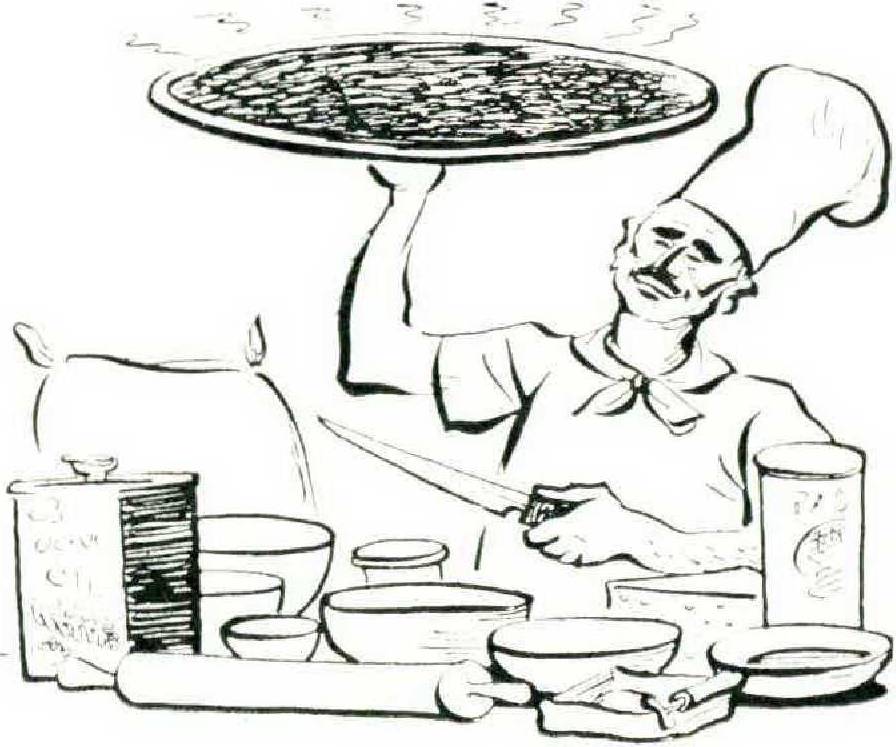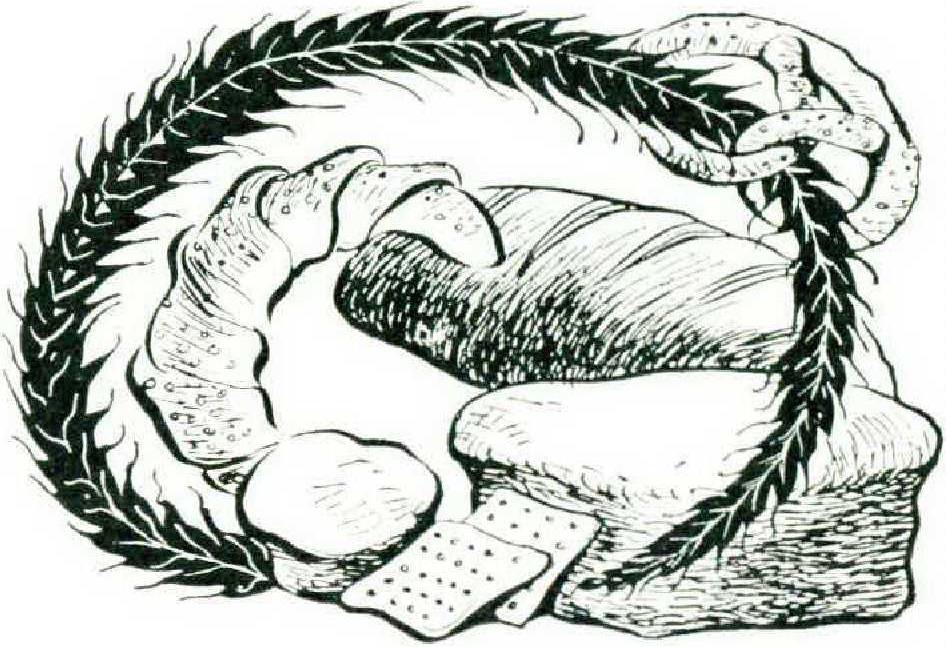Pizza
“In a world of ready-made food, packaged to be tossed together by amateurs, pizza stands apart—one dish, at least, which calls for time and skill.”

The waiter moves aside the glasses of red wine, and sets before you a king-sized open pie. It is piping hot; the brown crust holds a bubbling cheese-and-tomato filling. There is a wonderful savor of fresh bread, melted cheese, and herbs. This is a pizza, Italian for pie. There is a plural, pizze, but no one ever uses it, for pizza is a sociable dish, always intended to be shared. Two people order a small pizza, about a foot in diameter. A large pizza is twice that size. Don’t imagine an American pie blown up to about two feet, however; a pizza is a nearer relation to a pancake. It is very flat, made of raised bread dough, with the filling spread on top.
In a world of ready-made food, packaged to be tossed together by amateurs, pizza stands apart—one dish, at least, which calls for time and skill.

Naples and the province of Napoli created pizza — just the invention you would expect of a laughing, convivial people, a dish made for family snacks, late suppers, and Carnival celebrations.
In this country, you can find it wherever there is an Italian colony, from the Latin Quarter in San Francisco to Bleecker Street in New York to Hanover Street in Boston. You eat it, usually, sitting in a booth in a bare, plain restaurant, with a mural of Vesuvio on the walls, a juke box, and a crowded bar. The customers are Italian families, Bohemians, lovers, and—if a college is near-by—students and faculty members.
If you go back into the kitchen, most pizza-makers are happy to show you their routine. They’re a friendly, casual class—nothing of the high-capped chef about them. To see them roll and twirl the pizza dough, spread the filling, and slide the pie into the oven, you would think theirs the simplest job in the world; but a baker spends months, or even years, in learning pizza-making to perfection. One Neapolitan told me that it takes two generations (he had learned from his father, now ninety-seven and still baking pizza in Italy, just as his five sons do).
Pizza begins with a brick oven. Without the hot, evenly heated brick oven floor, you cannot have pizza. Big Italian commercial restaurants may use gas-heated ovens, with sides of metal, but the floors are brick. The best oven is all-brick, heated by coal or coke, with even, long-lasting heat on all sides.
The pizza-maker, with his brick oven at one side, works surrounded by bowls of pizza sauce made of ground tomatoes (this is put up in gallon cans for restaurants or for anyone else who can use that quantity), and bowls of garnishes: ground cheese, anchovies, shredded green peppers, thinly sliced mushrooms, sliced Italian sausage, onion rings, bits of salami, and anything else an inventive pizza-maker can dream up. Garlic and chopped orégano (wild marjoram) are the seasonings, used as the customer may request.

You may order a pizza with one, two, or any other number of garnishes; if you’re really wealthy—and hungry—order one with everything on top. Couples with different tastes may order a pizza with one garnish on half of it, another garnish on the other half.
Somewhere near the floured breadboard is a great mixing bowl filled with pizza dough—a “hard” dough, made with salt, water, flour, and yeast. From this great, mass, chunks are cut off according to size (small, medium, large pizza), made into mounds, and put into the floured drawers of a cabinet to rise. The baker takes the right size from the drawer as he needs it.
First he rolls the dough with a rolling pin. Then he places this large flat pancake on his closed fist, like a floppy hat, and twirls it round and round. The elastic dough becomes thinner and thinner. A skilled pizza-maker knows exactly when to stop twirling: when the cake is at its thinnest, just before it breaks through.
The very thin circle of dough goes back on the board, which has been sprinkled with yellow corn meal to keep the dough from sticking on the brick oven floor—no pans are used in baking pizza.
Now the filling or, more accurately, the covering. First the baker spreads a thin layer of the tomato pizza sauce. He strews this with handfuls of ground cheese, not quite covering the tomatoes. The cheese, traditionally, should be Mozzarella, a mild cheese made in Napoli; here, it is a local cheese made of skimmed milk. If a mild cheese is used, the whole pizza is covered generously with grated Parmesan-type cheese, for extra flavor. Olive oil may be sprinkled over the top. The most delicious pizza I ever tasted broke all traditions by being made with a combination of Munster and light American Cheddar.
When the garnishes have been added, the baker flops the pizza onto a short-handled wooden shovel, opens the oven door, and gently slides the pizza directly onto the brick oven floor. Only experience gives a baker the skill to do this without buckling the dough or spilling the garnish, and to remove the pizza when it is done, on a long-handled shovel, without breaking or even nicking the crisp crust.
After the pizza is taken out of the oven it is slipped onto a large aluminum pan, out into pie-shaped pieces with a very sharp knife, and sent out to the pizza-eaters. Everyone eats it using his fingers.
You can take home a pizza in a paper box and reheat it, but you should live near enough to serve it within twenty minutes or so. People do reheat pizza which has become cold, but it isn’t very good; the cheese may be stringy, and the crust rocklike at the edges, soggy on the bottom.
Regardless of what you may read, you cannot make pizza at home. Not unless you have a brick oven, two wooden shovels, and the knack of making a hard dough and twirling it out to twice its size. You may be able to make a concoction of tomatoes and cheese, but not real pizza. I am convinced that all yeast dough is possessed of a devil, so that it rises too much, or not enough, or at the wrong time. Anyone who thinks she can manage it, and shrugs aside the difference between a brick oven floor and a pan in a metal oven, can go to any Italian market for the essential tomato purée, cheese, olive oil, and orégano.

I think any would-be pizza is just too much trouble and hard, hot work. Much easier, if you are content with fake pizza, is the English muffin type, made by spreading half a muffin with olive oil (for flavor), then with tomato purée or canned tomatoes, topped with a slice of cheese, and any garnish you like. Bake about fifteen minutes in a hot oven. I will not reveal its low estate by naming it, but I actually found one Italian restaurant which serves English muffin pizza—a shock only to be compared to being served store doughnuts in a Vermont farm kitchen.
Try pizza some crisp fall night, some frosty winter evening. But remember to eat your first pizza — and all that follow — in good company. It should always be pizza al’amicizia.